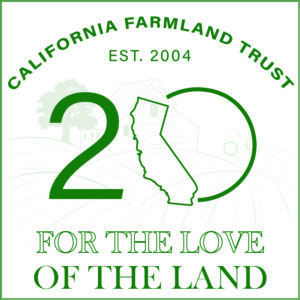 Passion Drives Action to Minimize Increasing Growth
Passion Drives Action to Minimize Increasing Growth
~ By Vicky Boyd
With development of prime farmland occurring all around them, a small group of Merced County residents had reached a tipping point in the early 1990s. Led by Linda Macedo, Eleanor Lema and a few other members of the Merced chapter of California Women for Agriculture, they wanted a way to protect the limited resource while still allowing agriculture to thrive.
Their solution was the formation of the Merced County Farmland and Open Space Trust, which at the time it was established in 1993 was a novel concept, said Maxwell Norton, a University of California Cooperative Extension farm advisor emeritus for Merced County. “Most of the early land trusts were environmental trusts for habitat or primarily open space trusts,” he said. “At the time, we really didn’t know exactly where we were going so we called it farmland and open space trust because we were also open to rangeland.”
As the Merced County efforts grew, the trust eventually merged with three other regional programs in 2004 to form the Central Valley Farmland Trust and focus on their strength – irrigated prime farmland. More than a decade later, the CVFT merged with the Brentwood Agricultural Land Trust in 2017 to form the California Farmland Trust.
At the time of the Merced trust’s formation, Merced County was one of the top 10 counties in the nation in terms of farmgate value. “There was a lot of development going on that wasn’t in the best interest of farming,” said Diana Westmoreland Pedrozo, one of the trust’s founding members.
Even early on, the Merced land trust proved successful. According to a 2007 article from the California Planning & Development Report, Merced County had nearly 10,000 acres held in agricultural easements. That was more than any other county in the state, and the publication credited the 1993 establishment of the Merced land trust.
Although the Merced County Farm Bureau was not directly involved with the trust formation, then Executive Director Mike Wade said it was supportive and provided meeting space. Farm Bureau members also were concerned about the pace of development. “There was just this very high interest in farmland protection,” he said. “Farm Bureau was driving it to a great degree. I was testifying at the Board of Supervisors almost every week or two on applications to convert farmland.”
Thinking Outside The Box
Macedo, along with a few forward-thinking CWA members, began talking among themselves about how they could protect farmland from development while still allowing farming to continue.
A farmland trust allows just that. Willing landowners either donate or sell their development rights to the trust. Landowners can continue to farm whatever crops they want, and they’re free to sell the land or pass it on to the next generation with the caveat that it remains in agriculture. When they first proposed the Merced land trust, Norton said, they conducted several outreach meetings to educate the public about the concept. CWA members also sought help from the American Farmland Trust with educational efforts. While most of the reception from farmers was positive, he said there were a few people who were suspicious of any outsiders.
Norton pointed out that placing land in a trust is 100% voluntary and involves a complex set of legal transactions to ensure the land, the owners, and the trust are all adequately protected. “We don’t go out and try to talk people into it — the initiative is from the landowners themselves,” he said. “And we always have more applications than we have funds for.”
Westmoreland Pedrozo viewed the farmland trust as providing another option for landowners. “It offers people alternative and different ways to operate and use different tools to make their operation more successful and sustainable, both financially and under the rules and regulations of California,” she said.
Describing the formation of the Merced land trust as a grassroots effort, Wade said, “It was leaders in the farming community that wanted to see it happen. They had a vision and created the trust.”
A life-long resident of the northern San Joaquin Valley, Norton said he’s had a ring-side seat watching development of the region’s farmland over the years. Some of it was straight development while in other cases it involved dividing larger parcels into ranchettes. “Ever since post-World War II, the San Joaquin Valley has been growing pretty fast,” said Norton, who also serves on the CFT Board of Directors. So fast, in fact, that some believed the northern San Joaquin Valley would eventually expand to meet the San Francisco Bay Area.
Wade, who recently joined the CFT Board, said it was hard to pinpoint just one cause for the growth that spurred the Merced farmland trust formation. In the early 1990s, the county was grappling with policy issues and was also dealing with general plan revisions and antiquated subdivisions.
Westmoreland Pedrozo also pointed to Castle Air Force base, which before its 1995 closure had been the county’s major employer and had driven overbuilding of apartments and housing. At the same time, Silicon Valley’s explosive growth in the 1990s pushed out residents, forcing them to move into the San Joaquin Valley.
This article is one of a series of articles highlighting the history of the California Farmland Trust, which celebrates its 20th anniversary in 2024.
